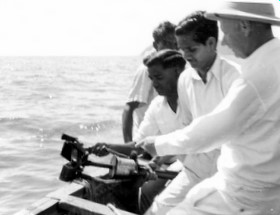Publication abstracts
Title: Oceanographic Studies in the Bay of Bengal
Title: The Bay of Bengal
The Bay of Bengal has several remarkable features. It has a huge influx of fresh water from several major rivers, it is affected by intense northeast and southwest monsoon winds, of which the latter breed cyclones. In the bay there is a seasonal anticyclonic coastal current which is seasonally replaced by a cyclonic current, and unlike most coastal regions, there is a western boundary coastal upwelling.
Title: Marine Sciences of the Seas around India between 1874 and 2000 and Prospects for the New Millennium
From an oceanographer's perspective, the Bay of Bengal and the Arabian Sea constitute an ideal laboratory. The round of meteorological, hydrological, and biological events is governed by a) influx of large freshwater from several major rivers, b) intense northeast and southwest monsoon winds of which the latter breeds cyclones in the Bay of Bengal, unique to these waters. Additionally, these waters support various tropical biotopes such as estuaries, mangroves, brackish water lakes, coral reefs, islands, and offshore waters with a great diversity of fauna and flora. The steadily growing coastal population (~ 200 million) heavily utilizes the coastal zone for urban settlements, fishing, mariculture, marine transport, recreation, offshore oil and gas exploration, and dumping of wastes.
